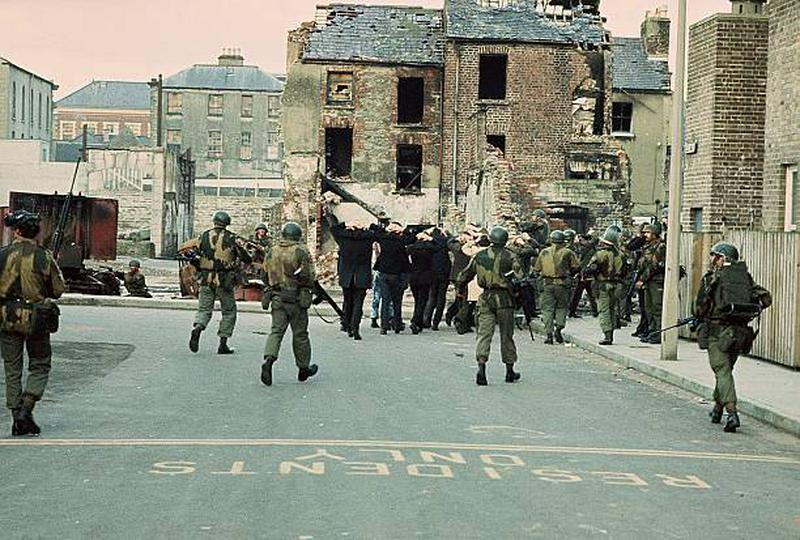Bloody Sunday: A Massacre During A Civil Rights March
By | September 4, 2021

In 1969, Derry, the second largest city in Northern Ireland was struggling with poverty and inequality between the Nationalists (who were in the majority) and the Unionists. Despite the Nationalist majority, because of gerrymandering and discriminatory laws against the Catholics, the Unionists maintained leadership in all council roles. In addition to poverty, the housing conditions were terrible; Catholics wanted improvement.
The Northern Ireland Civil Rights Association (NICRA) began as a non-partisan organization, and included Unionists. However, Sinn Fein and the Official IRA began to have more influence. The NICRA aimed to defend and protect freedoms and rights of all citizens, highlight abuses of power, demand guarantees for freedom of speech, assembly, and association, and inform the public of their rights. In an attempt to wipe out the NRA, internment with trial was introduced in Northern Ireland on August 9, 1971, so anyone suspected of being a member of a terrorist organization could be arrested on the spot. Many innocent people were arrested and the British army arrested some people in their homes. Despite the fact that marches were banned as of January 18, 1972 in Northern Ireland, the NICRA organized marches against internment. One of these marches, on January 30, 1972, would become known as Bloody Sunday.

Trying To Avoid Conflict
They were asked to change the route of the march to contain it in the Catholic area of Derry, part of which was called Free Derry, as it was a “no-go” area for the British Army. Barricades kept military vehicles from entering the area, and IRA members regularly openly carried weapons there. The situation angered the British Army, who vowed to use tougher measures to control the situation. They introduced the Parachute Regiment, an elite group which employed more severe methods than the regular British soldiers. On Bloody Sunday, the Parachute Regiment was deployed to deal with anticipated riots. Out of concern for the possibility of violence, the IRA was asked to not participate.

The March Begins
Approximately 10-15,000 people joined the march, which began in Creggan at 3 p.m., and proceeded to the Bogside, the largely Catholic area outside Derry’s Old City walls. The Army erected barricades to keep the protesters from accessing the city center, and behind each barricade, there would be a number of soldiers and two armored personnel carriers. If a protester were to breath the barrier, the soldiers were allowed to use rubber bullets, cannons, and tear gas. The organizers changed the route because of the barricades, moving the rally to the Free Derry Corner. Meanwhile, paratroopers had established camp in a derelict building, with the goal of launching an arrest operation.

The Murder Of Innocent People
When marchers noticed paratroopers in the building, they threw stones at them; in response the soldiers fired real bullets, injuring two. The soldiers claimed that the protesters were throwing nail bombs, but no evidence was ever found. At 4:10, the soldiers entered the Bogside. When the armored personnel carriers entered, many people tried to flee and the paratroopers began seizing people, beating them, and firing rubber bullets at close range. The soldiers fired on people who were near a rubble barricade along Rossville Street. They killed six and wounded one. A group of protesters fled into the car park of Rossville. It was surrounded on three sides by high-rise buildings, and the soldiers injured six civilians. They shot one in the back, 17-year old Jackie Duddy, who had been running alongside Edward Daly, a priest. Another group was similarly trapped in the car park of Glenfada Park, and two were killed and at least four others were wounded. Ten minutes after the soldiers had entered Bogside, they fired more than 100 rounds, shooting 26 people. Thirteen died that day and one succumbed to his injuries four months later. That man, John Johnston, was not part of the protests, but was walking to visit a friend in Glenfada Park. One man, Bernard McGuigan, had rushed over to help an injured man and was waving a white handkerchief when a British soldier shot him in the head. Some consider Bloody Sunday to have intensified the Troubles in Northern Ireland, and the anger that it sparked led an angry to burn down the British Embassy in Dublin.

Two Enquiries, Thirty Years Apart
Two days after Bloody Sunday, the Widgery Enquiry began; it was completed 10 weeks later, but most witnesses considered this enquiry a whitewash. Thirty years later, in 1998, the Saville Enquiry was launched. It reached drastically different conclusions from Widgery when it finally ended seven years later and was released to the public in 2010. When it was released, then Prime Minister David Cameron apologized, saying, “What happened on Bloody Sunday was both unjustified and unjustifiable. It was wrong."
